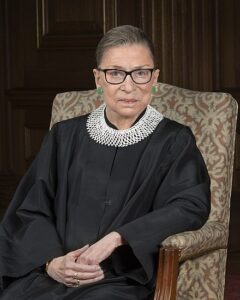
Ruth Bader Ginsburg (March 15, 1933-Sept. 8, 2020) was born in Brooklyn as Joan Ruth Bader to Nathan Bader and his wife Celia Amster, both of whose heritages were Eastern European Jewish. Because there were other girls named Joan in Ginsburg’s elementary school classes, her mother suggested that she be called by her middle name. The Bader family attended Mildwood Jewish Center, a Conservative synagogue, which at the time did not offer bat mitzvah ceremonies, which upset the future Associate Justice of the Supreme Court. As a child Ginsburg attended a Jewish summer program at Camp Che-Na-Wah near Minerva, New York, and rose to the position of camp counselor. Her mother died the year before her high school graduation.
She graduated with a bachelor’s degree in government from Cornell University, where she met and married Martin Ginsburg, an ROTC graduate who was called up for the Korean War. They moved to Fort Sill, Oklahoma, where Ruth worked for the Social Security Administration until she became pregnant in 1955 with her first child, Jane Ginsburg, who would follow Ruth into the practice of law. A son, James Steven Ginsburg, was born in 1965, and he became president of a recording company that specialized in classical music. In 1956, Ruth Bader Ginsburg was one of nine women to enroll at Harvard Law School in a class with approximately 500 men. The law school dean, Erwin Griswold, asked the women in the class why they were taking the places of men. When her husband got a job as a tax attorney in New York, she transferred to Columbia Law School, tying for first place in her graduating class.
She sought a clerkship with Supreme Court Justice Felix Frankfurter, who rejected her because of her gender. She then clerked with Judge Edmund Palmieri of the U.S. District Court for the Southern District of New York for two years. From 1961 to 1963, Ginsburg worked at the Columbia Law School Project on International Procedure, and then lived in Sweden to coauthor a book with Anders Bruzelius on that country’s civil procedure. There she found that 20 to 25 percent of the law students were women, which had an impact on her developing attitude about women’s rights. In 1963, Ginsburg was hired as a law professor at Rutgers Law School and was paid less than her male colleagues because, she was told, “your husband has a very good job.” She remained at Rutgers through 1972, two years after she founded Women’s Rights Law Reporter, which focused on cases involving the legal rights of women.
In 1972, she transferred to Columbia Law School, where she authored a casebook on sex discrimination. She was at Columbia until 1980, but spent 1977-1978 at Standford University’s Center for Advanced Study in the Behavioral Sciences. Beginning in 1972, Ginsburg was part of the American Civil Liberties Union Women’s Rights Project, which she co-founded. She argued six gender discrimination cases before the U.S. Supreme Court between 1973 and 1976, winning five. She took cases that could build upon prior victories, representing both men and women to show that gender discrimination was harmful to both men and women.
In 1980, she was appointed by President Jimmy Carter to a seat on the District of Columbia Circuit Court, where she was able to find common ground with such conservative colleagues as Robert H. Bork and Antonin Scalia, the latter of whom she would serve with on the U.S. Supreme Court. Although they had different judicial philosophies, they had a close friendship and a common interest in opera.
President Bill Clinton nominated Ginsburg to the Supreme Court in 1993, and the Senate confirmed her on a 96-3 vote, thereby filling the seat that had been vacated upon the retirement of Byron White. She was the first Jewish female justice of the Supreme Court, and eventually became the longest-serving Jewish justice. When Sandra Day O’Connor retired in 2006, Ginsburg temporarily became the only woman on the nine-member court.
She authored the decision in 1996 in the United States v. Virginia in which the male-only admissions policy of the Virgina Military Institute was ruled unconstitutional. She wrote the dissent in the 2007 Ledbetter v. Goodyear case in which the majority ruled that the statute of limitations had run out for a complaint of unequal pay. Ginsburg said that Lilly Ledbetter had not originally known of the unequal pay, so the statute of limitations shouldn’t have kicked in until the discrimination became apparent. Congress subsequently changed the law to make it easier for employees to win pay discrimination claims. In 1999 in Olmstead v L.C., she wrote the majority opinion that mental illness is a disability covered under the Americans with Disabilities Act of 1990. In 2000, she supported the right of residents to seek fines for industrial polluters in Friends of the Earth, Inc. v. Laidlaw Environmental Services, Inc.
In 2010 when Justice John Paul Stevens retired at the age of 90, Ginsburg at age 77, with a history of cancer, became the oldest justice on the court Liberal Democrats sought to persuade Ginsburg to retire during the administration of Barack Obama so that he could nominate a like-minded younger successor, but she refused, saying she wished to remain as long as she was mentally sharp. She died at age 87, less than four months before Joe Biden succeeded Donald Trump as president. Trump quickly nominated Amy Coney Barrett as her successor, who was approved by the U.S. Senate.
For her sometimes fiery dissents, Ginsburg was nicknamed “The Notorious RBG.” She remained a pop culture icon even after death.
Tomorrow, March 16: Jerry Lewis
*
SDJW condensation of a Wikipedia article